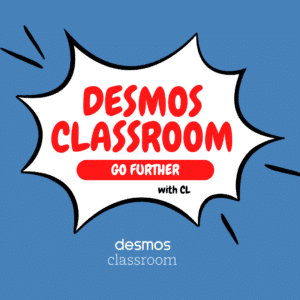Desmos Classroom is a free way to design an interactive lesson. In my previous blog post I shared how to get started with building a lesson. The lesson builder is easy to use, use the left side panel to insert interactive elements onto the page. While simple to get started, you can increase the power with the Desmos Classroom Computation Layer (CL).
OTIS Workshops with Alice Keeler
OTIS provides professional learning opportunities with a certificate! Join Alice Keeler for a session on how to “personalize” activities with the Desmos Classroom Computation Layer. Log into otis.teq.com for free and navigate to “Upcoming courses.” Email otis@teq.com if you have any issues registering.
Customize Your Lessons with the CL in Desmos
Looking for a way to create dynamic and interactive digital lessons? The Desmos platform is completely free and allows for any topic to be created or customized. Create a class or even sync with your Google Classroom roster! Whether short answer, multiple choice, sorting, sketching, etc., you can review all student responses in real time through the teacher dashboard. Author and educator Alice Keeler will show you how to go one step further with the custom activities in Desmos as we introduce you to the computation layer (CL). Alice will show you how to personalize your lessons using the CL to include your students’ names and show student responses from one screen in another screen.
Building Custom Activities in Desmos Classroom
Start by logging into teacher.desmos.com. Desmos Classroom is free. On the left hand side, locate the option for “Custom Activities.” Create a new activity, or edit a pre-existing lesson.
What is the Computation Layer?
At its core, the Desmos Classroom Computation Layer is a scripting language designed to create dynamic, interactive activities. It allows educators to design content that responds to students’ inputs in real-time, providing immediate feedback and adapting to different learning scenarios. DCL is the engine behind Desmos activities, enabling the development of customized learning experiences that promote engagement and understanding.
Look for the < / >
Coding, or scripting, often is symbolized by the symbol < >. If you have ever used any HTML you’ll be familiar with <b>tags</b> that surround the text to indicate formatting. While the Computation Layer in Desmos does not use <tags> in this format, this universal symbol is used to signify where you can use the scripting code. Look for the < / > as an opportunity to customize the activity.
In this customized activity I used the Desmos Classroom Computation Layer (CL) to allow students to input their name on the first screen. I can then use this value, their name, on subsequent screens to offer a personalized view for each student.
Computation Layer Documentation


Within the activity builder you will notice the < / > symbol above the buttons on the left hand side. You will also notice it in the upper right of the activity cards that you add to the screen.
Try Customizing the Title
When adding a screen, the top option is to add a title. You can customize this title with the CL. Click on the < / > above the buttons on the left side.
Customize Your Lessons with the CL in Desmos
Looking for a way to create dynamic and interactive digital lessons? The Desmos platform is completely free and allows for any topic to be created or customized. Create a class or even sync with your Google Classroom roster! Whether short answer, multiple choice, sorting, sketching, etc., you can review all student responses in real time through the teacher dashboard. Author and educator Alice Keeler will show you how to go one step further with the custom activities in Desmos as we introduce you to the computation layer (CL). Alice will show you how to personalize your lessons using the CL to include your students’ names and show student responses from one screen in another screen.
The right side of the Computation Layer Script provides you with options for “Sinks” you can use with that element. A “Sink” is the first thing you start with on a line to indicate what you want to code.
Try coverText
Capitalization is important! Start the line with
coverText:
Following the colon (important) put the text you want to cover the screen within “quotations.”


What is nice about the Computation Layer (CL) is that it is relatively simple. I type the sink with a colon. Text needs to be in quotations. But that is it. Click done. This will provide students with some directions to read before they start on the activity on the screen.
Learn the CL Structures
Each sink has a different set of parameters for how to express the code. Use the documentation for examples on the specific formatting.
Using Variables
Variables are one of the ways that the CL is really useful. You define a variable, such as the answer a student input on screen 3. This response is then incorporated into the activity on screen 5 perhaps.
On the activity cards there is a line to be able to name that element. Make it one word without spaces. This will allow you to refer to the response put into that activity card. This activity card name is called a “variable.”


On a different activity screen I used the < / > icon above the buttons. Using the sink “title:” I put into quotations the generic text I want the student to see. Within the quotes, adding a ${} allows me to insert a variable value. In this case, I named the activity card where students input their name stuName. Starting to type stuName within the ${} automatically offers me the option of that varible.








